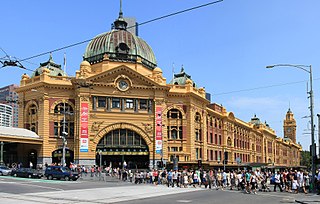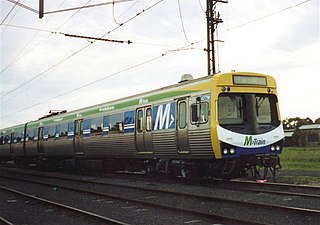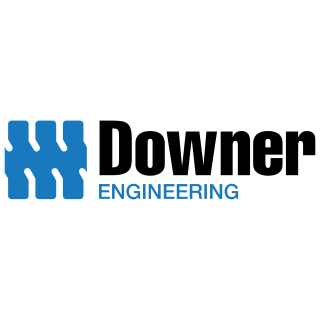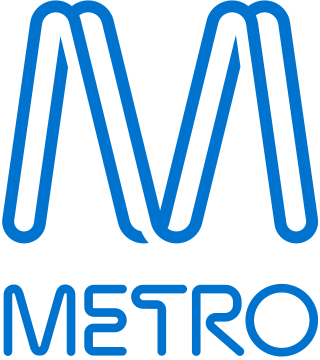
Pakenham railway station is the terminus of the suburban electrified Pakenham line in Victoria, Australia. It serves the south-eastern Melbourne suburb of Pakenham, and it opened on 8 October 1877. The station is also serviced by V/Line services to Traralgon and Bairnsdale.
The Pakenham line in Melbourne, Australia is a commuter rail passenger train service operating between Flinders Street in the Melbourne CBD and Pakenham in Melbourne's southeast. The service operates entirely on the Orbost main line and the City Loop. The service is part of the Public Transport Victoria metropolitan rail network and is operated by Metro Trains Melbourne.
The Cranbourne line is a commuter rail service operated by Metro Trains Melbourne in the south-eastern suburbs of Melbourne, Victoria, Australia. It operates along the inner section of the former South Gippsland line. The service is part of the Public Transport Victoria metropolitan train network.

The Melbourne rail network is a passenger and freight train system in the city of Melbourne, Victoria, Australia. The metropolitan passenger rail network is centred on the Melbourne CBD and consists of 222 stations across 16 lines, serving a yearly ridership of 243.2 million. It is the core of the larger Victorian railway network, with links to both intrastate and interstate systems.

Connex Melbourne was a train operator in Melbourne, Australia. Formed in October 1997 as Hillside Trains, a business unit of the Public Transport Corporation, it was privatised in August 1999 becoming a subsidiary of Connex.

The Siemens Nexas is a class of electric multiple units manufactured by Siemens Transportation Systems for the suburban railway network of Melbourne, Australia between 2002 and 2005. The design of the trains was based on the Siemens Modular Metro.

The Hitachi was an electric multiple unit that operated on the Melbourne suburban railway network between 1972 and 2014. Electrical equipment was supplied by Commonwealth Engineering to designs by Hitachi of Japan, leading to their official name today, though no actual Hitachi-supplied components were used in their construction. They were the last suburban trains in Melbourne with no air conditioning. A total of 355 carriages were built between 1972 and 1981, including a replacement carriage for one written off while the fleet was still being delivered.

Downer Group is an integrated services company active in Australia and New Zealand.

M-Train was a train operator in Melbourne, Australia, and operated some of the city's suburban rail operations. Formed in October 1997 as Bayside Trains, a business unit of the Public Transport Corporation, it was privatised in August 1999 becoming a subsidiary of National Express.

The Comeng train is a type of electric multiple unit (EMU) that operates on the suburban railway network of Melbourne, Victoria, Australia. Built by Commonwealth Engineering (Comeng) in Dandenong, they were introduced in 1981 as a replacement for the Tait and Harris trains. In total, 570 carriages were built.

Downer Rail is a business unit within the Downer Group. As well as manufacturing and maintaining railway rolling stock it holds maintenance contracts to maintain rail infrastructure. The head office is located in North Ryde.

CRRC Changchun Railway Vehicles Co., Ltd. is a Chinese rolling stock manufacturer and a division of the CRRC. While the CRV emerged in 2002, the company's roots date back to the establishment of the Changchun Car Company in 1954. The company became a division of CNR Corporation before its merger with CSR to form the present CRRC. It has produced a variety of rolling stock for customers in China and abroad, including locomotives, passenger cars, multiple units, rapid transit and light rail vehicles. It has established technology transfer partnerships with several foreign railcar manufacturers, including Bombardier Transportation, Alstom, and Siemens Mobility.
The X'Trapolis 100 is a class of single deck electric multiple units part of Alstom's X'Trapolis family of trains, operated in Melbourne, Victoria, Australia and Valparaíso, Chile.

The Sydney Trains A & B sets, also referred to as the Waratah trains, are classes of electric multiple units that currently operate on the Sydney Trains network. Based on the M sets, the Waratahs were manufactured by a joint consortium between CRRC Changchun and Downer Rail, with initial construction taking place overseas in Changchun before final assembly at Downer Rail's Cardiff Locomotive Workshops. The sets were named after the Waratah flower, which is the state's floral emblem.

Metro Trains Melbourne, often known simply as Metro, is the franchise operator of the electrified suburban passenger service on the Melbourne rail network. Metro Trains Melbourne is a joint venture between Hong Kong-based MTR Corporation (60%), John Holland Group (20%) and UGL Rail (20%). The three constituent companies are also partners in the Metro Trains Sydney joint venture, which has operated the Sydney Metro network since 2019.

The Metro Tunnel is a metropolitan rail infrastructure project currently under construction in Melbourne, Australia. It includes the construction of twin 9-kilometre rail tunnels between South Kensington and South Yarra with five new underground stations. The tunnel will connect the Pakenham and Cranbourne lines with the Sunbury line, creating a new cross-city line that bypasses Flinders Street station and the City Loop. From 2029 the line will also serve Melbourne Airport via a new branch line west of Sunshine station.
The Network Development Plan Metropolitan Rail is a long-term development plan for the rail network of Melbourne, Australia. It was carried out by Public Transport Victoria (PTV) and released to the public on 27 March 2013 however, a revised version was leaked in 2019 making a few changes to the plan.
Melbourne Airport Rail is a rail link under construction from the Melbourne CBD to Melbourne Airport at Tullamarine. Since October 2022 the project has also been branded as SRL Airport. The rail link is to run through the under-construction Metro Tunnel, running 27 km from the airport to Town Hall station in the city centre with 12 km of new track between the airport and Sunshine station. The link will be a new branch of the Melbourne Metro rail network and run High-Capacity Metro Trains at a 10-minute frequency. The project is being delivered by the Victorian state government agency Rail Projects Victoria.

Rail Projects Victoria (RPV) is an agency of the Government of Victoria, Australia, responsible for the management of certain major infrastructure projects on the Victorian rail network. Originally established as the Melbourne Metro Rail Authority (MMRA), to deliver the Melbourne Metro Rail Project, the office was later expanded in its responsibilities to include the management and planning of a number of major infrastructure programs on V/Line's regional rail services. It was renamed RPV in 2018 to reflect its expanded scope, and later became one of several project teams comprising the Department of Transport's Major Transport Infrastructure Authority.
The X'Trapolis 2.0 is a series of electric multiple unit (EMU) to be used for Metro Trains Melbourne, part of Alstom's X'Trapolis family. The trains are to start construction in 2022 and enter service between 2024 and 2026. The trains will continue replacing the ageing Comeng fleets on the Craigieburn, Frankston and Upfield lines alongside the High Capacity Metro Trains, which are also currently being built. The trains' maximum capacity is 1241 unlike the Comeng, which had/has a capacity of 1127.



















